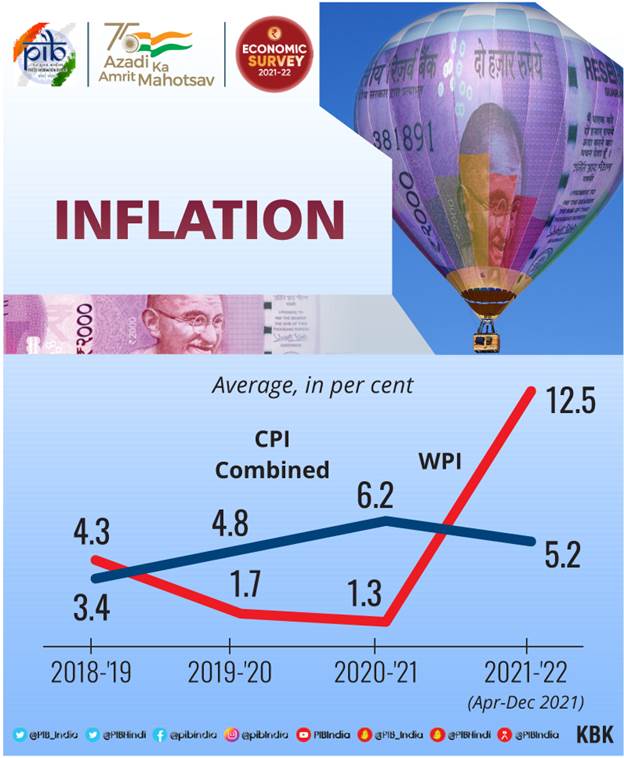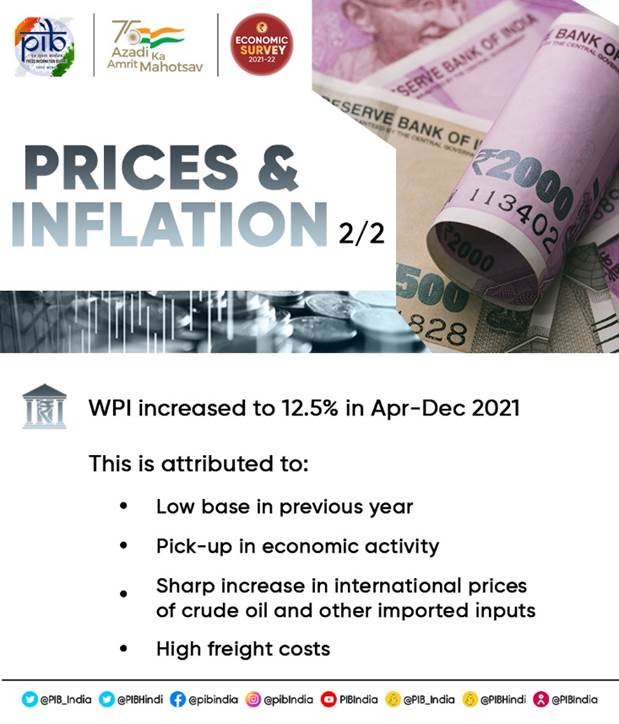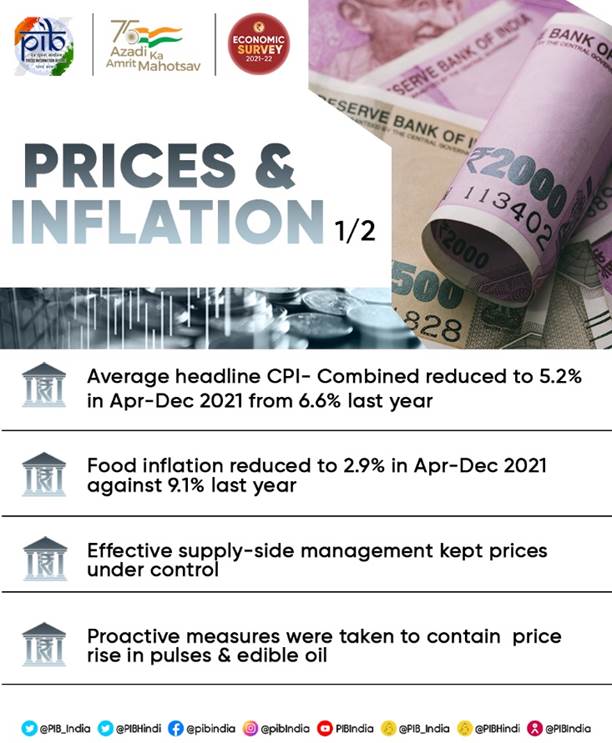Ministry of Finance
RETAIL INFLATION REMAINS MODERATE DURING CURRENT YEAR; 5.2% IN 2021-22 (APRIL-DECEMBER)
EFFECTIVE SUPPLY-SIDE MANAGEMENT KEPT PRICES OF MOST ESSENTIAL COMMODITIES UNDER CONTROL DURING THE YEAR
DIVERGENCE IN RETAIL AND WPI INFLATIONS EXPECTED TO NARROW DOWN
प्रविष्टि तिथि:
31 JAN 2022 2:54PM by PIB Delhi
The retail inflation, as measured by Consumer Price Index-Combined (CPI-C) moderates to 5.2% in 2021-22 (April-December) from 6.6% in the corresponding period of 2020-21, says the Economic Survey 2021-22 presented by the Union Minister for Finance & Corporate Affairs, Smt Nirmala Sitharaman in the parliament today. The Survey also says effective supply-side management kept prices of most essential commodities under control during the year.

Domestic Inflation:
Compared to many Emerging Markets and Developing Economies (EMDEs) and advance economies, the Survey finds that Consumer Price Index – Combined (CPI-C) inflation in India has remained range bound in the recent months, touching 5.2% in December 2021. This was possible largely because of the proactive steps taken by the Government for effective supply management.
Global Inflation:
The Economic Survey says that in 2021, inflation picked up globally as economic activity revived with opening up of economies. Inflation surged from 0.7 % in 2020 to around 3.1 % in 2021 in the advanced economies. For instance, inflation in the USA touched 7.0 % in December 2021, the highest since 1982. In the UK, it hit a nearly 30 years high of 5.4% in December 2021. Among emerging markets, Brazil witnessed inflation of 10.1% in December 2021 and Turkey also saw double digit inflation touching 36.1%. Argentina has been experiencing inflation rates above 50% during the last 6 months.
Recent Trends in Retail Inflation:
Retail inflation, well within the target limits of 2% to 6%, declined to 5.2% as against 6.6% during April – December 2020-21. The Survey states that this was largely attributed due to the easing of food inflation. Food inflation, as measured by the Consumer Food Price Index (CFPI), averaged at a low of 2.9% in 2021-22 (April-December) as against 9.1% in the corresponding period last year.
The Survey says that a “refined” Core inflation has been constructed to exclude the volatile fuel items. The items of “petrol for vehicle” and “diesel for vehicle” and “lubricants & other fuels for vehicles”, in addition to “food and beverages” and “fuel and light” have been excluded from headline retail inflation. Since June 2020, refined core inflation has been much below the conventional core inflation, indicating the impact of inflation in fuel items in the “conventional” core inflation measure.
Drivers of Retail Inflation:
Major drivers of retail inflation have been “miscellaneous” and “fuel & light” group. Contribution of miscellaneous increased to 35% in 2021-22 (April – December) from 26.8% in 2020-21 (April – December). According to the Survey, within miscellaneous group, subgroup of “transport and Communication” contributed the most, followed by “health”. On the other hand, contribution of food & beverages declined from 59% to 31.9%.
“Fuel & light” and “Transport & Communication”:
The Survey mentions that Inflation in the above two groups for the period of 2021-22 (April – December) has been largely due to the high international crude oil, petroleum product prices and higher taxes.
Miscellaneous:
The Survey expresses that apart from transport & communication; “clothing and footwear” inflation also saw a rising trend during the current financial year possibly indicating higher production and input costs (including imported inputs) as well as due to revival of consumer demand.
Food and beverages:
According to the Survey, “Oils and fats” contributed around 60% of “food and beverages” inflation despite having a weight of only 7.8% in the group. The demand for edible oils is largely met through imports (60%) and fluctuations in international prices have been responsible for the high inflation in this sub group. Though India’s imports of edible oils have been the lowest in last six years, in terms of value, it has increased by 63.5% in 2020-21 as compared to 2019-20.
The Survey observes that inflation in pulses declined to 2.4% in December 2021from 16.4% in 2020-21.With an increase in area sown for kharif pulses to a new high of 142.4 lakh hectare (as on 1st October 2021) pulses inflation is on a downward trajectory.
Rural – Urban inflation differential:
The Survey notes that the gap between rural and urban CPI inflation declined in 2020 as compared to the higher gaps witnessed from July 2018 to December 2019. The factor largely responsible for divergence, for brief time periods, is the component of food and beverages.
Trends in Wholesale Price Index based Inflation:
WPI inflation has shown an increasing trend and has remained high during the current financial year touching 12.5% during 2021-22 (April – December). The Survey describes that part of the high inflation could be because of a low base in the previous year as WPI inflation has been benign during 2020-21.
The Survey observes that Crude petroleum & natural gas sub group under WPI has witnessed very high inflation and stood at 55.7% in December 2021. Within manufactured food products, edible oils were a major contributor.

Divergence between WPI and CPI based Inflation rates:
The Survey attributes a host of factors for the divergence witnessed between the two indices. Some of them, amongst others, include the variations due to base effect, conceptual difference in their purpose and design, the price behavior of the different components of the two indices and lagging demand pick up. The Survey states that with the gradual waning of base effect in WPI its divergence in WPI and CPI inflation is expected to narrow down.

Long term perspective:
The Survey states that given the importance of supply side factors in having a predominance in determination of inflation in India, certain long term policies are likely to help. This includes changing production patterns which would lead to diversification of production of crops, calibrated import policy to address uncertainty and increased focus on transportation and storage infrastructure for perishable commodities.
*****
RM/YB/BY/SV
(रिलीज़ आईडी: 1793808)
आगंतुक पटल : 9113